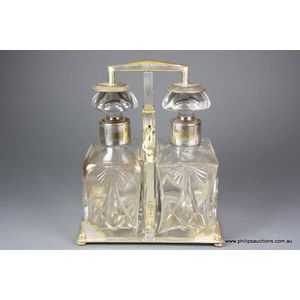Victorian Red Glass Scent Bottle and Vinaigrette
You must be a subscriber, and be logged in to view price and dealer details.
Subscribe Now to view actual auction price for this item
When you subscribe, you have the option of setting the currency in which to display prices to $Au, $US, $NZ or Stg.
- Canted Corners - In decorative arts, especially furniture making, a canted corner refers to a technique where the corner of the piece is angled or "canted" to create a diagonal corner. This is different from a chamfered corner which is a technique where the edges of a corner are cut at an angle, creating a diagonal edge or "bevel" along the corner.
A canted corner is typically used to add visual interest to the item. It can be found in various styles of furniture such as contemporary, Art Deco, or traditional. It is often used to create a sense of movement and dynamism in a piece.
Canting a corner is a more complex technique than chamfering, and it is typically done by tilting the corner of a piece of furniture and then cutting the wood to match the angle. It's a technique that requires precise measurements and a good understanding of angles and geometry, and it is usually done by experienced artisans. - Victorian Period - The Victorian period of furniture and decorative arts design covers the reign of Queen Victoria from 1837 to 1901. There was not one dominant style of furniture in the Victorian period. Designers used and modified many historical styles such as Gothic, Tudor, Elizabethan, English Rococo, Neoclassical and others, although use of some styles, such as English Rococo and Gothic tended to dominate the furniture manufacture of the period.
The Victorian period was preceded by the Regency and William IV periods, and followed by the Edwardian period, named for Edward VII (1841 ? 1910) who was King of the United Kingdom and the British Dominions and Emperor of India for the brief period from 1901 until his death in 1910.
This item has been included into following indexes:
- perfume / scent bottles, material
- perfume / scent bottles, period - Victorian 470
- Sampson, Mordan & Co. (England) - decorative items 83
Visually similar items

Two ruby glass scent bottles one with lid hallmarked Birmingham 1912, height 6 cm approx

Two Victorian scent bottles, one with red glass overlay and the other with gilt floral decoration, 8.5 cm tall (largest)

A slit gong drum with prominent finial, Benin, finial in the form of an ancestral bust, on a fitted metal stand, Benin, Nigeria. Provenance: Xanadu Gallery, San Francisco 1980/90s, South American private collector, height 50 cm

An Art Deco tantalus in a WMF silverplated frame, circa 1920, two squat rectangular decanters with pendant fan style incisions with silvered mounts and having faceted mushroom style stoppers, enclosed in a lockable frame, marked WMF and Alemania with addit
